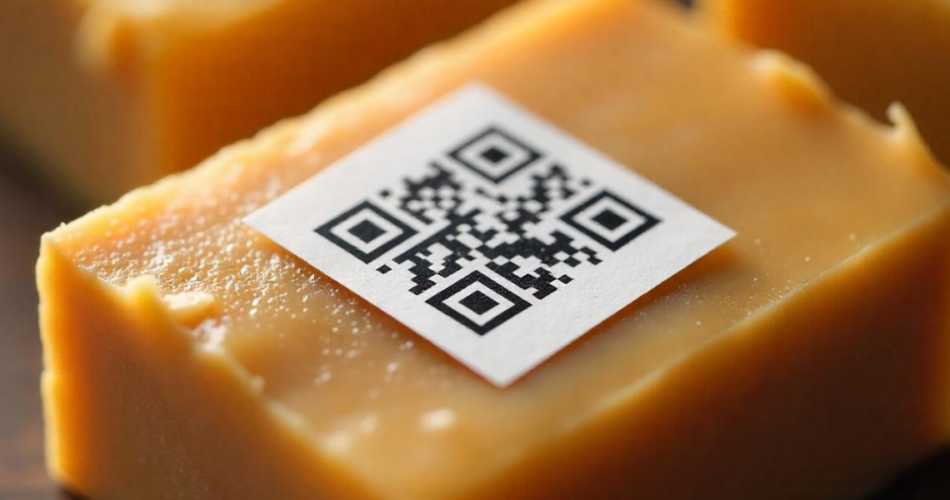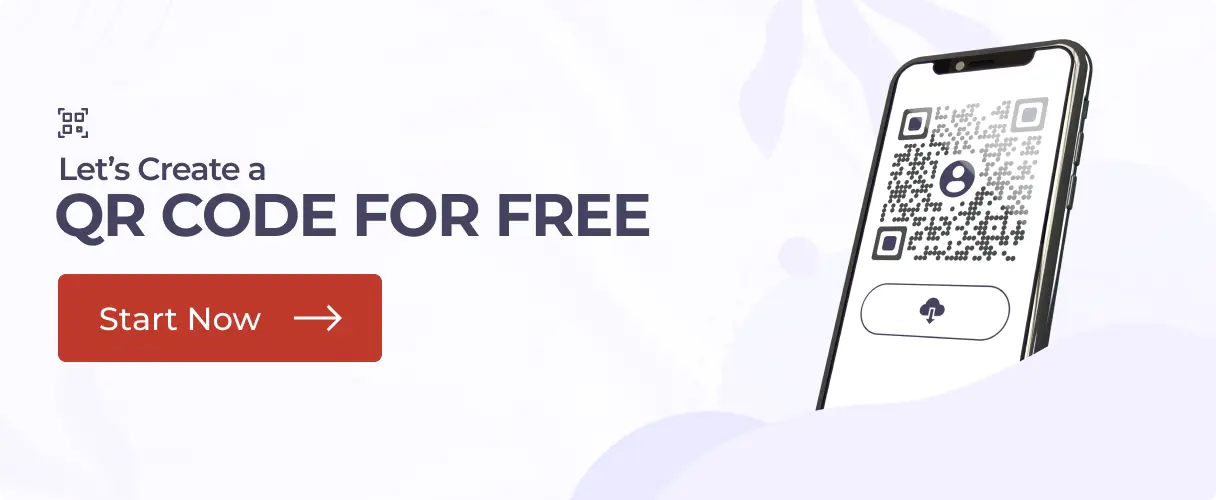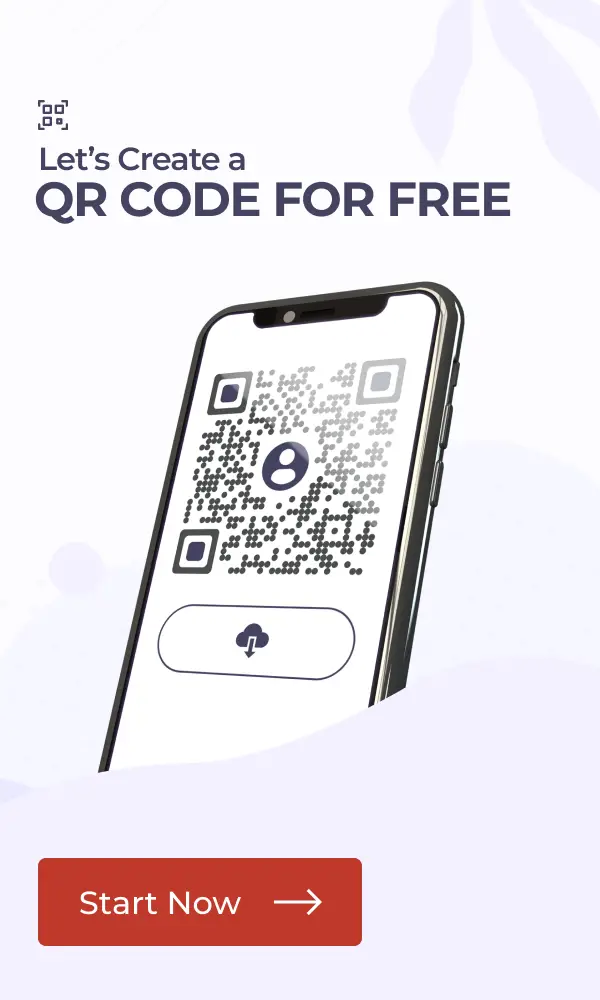In a nutshell: Running a small business is hard, but QR Code for small businesses make it easier. They’re easy to use and connect offline to online. From payments to promos, they boost engagement and cut costs. You can easily design and track branded QR Codes, no tech skills needed.
Let’s face it, running a small business today isn’t exactly easy. Between keeping customers happy, juggling operations, and trying to stand out from the crowd, it can feel like a constant race.
But when it comes to print media such as flyers, posters, brochures, or packaging, there’s one simple way to bridge the offline to online gap: QR Codes.
Those small black and white squares aren’t just trendy tech; they turn your print materials into interactive experiences that drive traffic, boost engagement, and help your business grow.
Before applying QR Codes to your business strategy, it helps to start with understanding QR Code use, from how they work to where they fit in different industries.
Originally built for tracking car parts (true story), QR Codes have gone from factory floors to front doors, helping small businesses like yours bridge the gap between the physical and digital world.
With just one scan, your customer can check out your website, read reviews, buy a product, and join your loyalty program—no typing, no app downloads, no friction.
And here’s the kicker: they’re insanely easy to set up and can save you time, money, and a whole lot of marketing headaches.
Want to cut down on printing costs? Done. Need a better way to engage customers? You got it. Looking to make your brand look like it’s from the future? Say no more.
In this post, we’ll break down exactly how small businesses are using QR Codes to punch above their weight.
Plus, we’ll share some pro tips, best practices that make creating high-converting QR Codes a total breeze.
The YoY growth of QR Code creations has increased by 156% for small businesses. Source: smbguide
A. So…Why should small businesses even care about QR Codes?
Let’s be real, if you’re a small business owner, you’re wearing 27 different hats on any given day.
You’re the marketer, the accountant, the customer support rep, and probably the one cleaning up after closing time. What you don’t need is another complicated marketing tool that promises growth but wastes your time.
QR Codes are simple, practical, and perfect for small businesses that rely on print media to reach customers.
Whether it’s on flyers, product packaging, or posters, they make it easy for people to scan, connect, and take action while making your brand look professional without extra effort.
Here’s why they’re a game-changer:
1. They turn anything into a digital touchpoint
Got a poster? Add a QR Code and turn it into an interactive experience.
Business card? Add a scan and let people save your contact instantly.
Menu? Link it to an online version so you can update prices without reprinting. Suddenly, every flyer, sign, or product label becomes a smart, trackable marketing tool.
2. They make payments fast and frictionless
People hate waiting. And digging for cash or cards? Forget it. QR Code payments let your customers pay in seconds using their phone—whether you’re in a retail shop, a food truck, or at a weekend market. It’s fast, secure, and makes you look legit.
3. They’re the ultimate no-pressure CTA
No hard selling, no awkward conversations—just a scan. QR Codes let customers explore at their own pace. They can browse your catalog, follow you on Instagram, sign up for your newsletter, or leave a review—without anyone hovering over their shoulder.
4. They’re marketing gold (with tracking built in)
Most print ads are a black hole—you spend the money, cross your fingers, and hope someone responds. With QR Codes, you can track scans, measure what works, and tweak your campaigns like a pro. You’ll finally have real data instead of just guessing.
5. They save you money (and trees)
Menus, brochures, forms—you name it. QR Codes help you ditch the reprints and keep everything updated online. That means less waste, fewer printing costs, and way more flexibility when you need to make changes on the fly.
6. They scale with your business
Whether you’re a solopreneur or running multiple locations, QR Codes grow with you. Want to launch a loyalty program? Done. Need to collect feedback at scale? Easy. Expanding to eCommerce? Link to product pages in seconds. It’s the kind of low-effort, high-impact tool every small business dreams of.
B. How can a small business create a QR Code?
If you are a small business owner and are worried that creating QR Codes requires tech knowledge, expertise, and lots of money, you’re wrong.
Follow this guide to create one for yourself easily.
1. Go to Scanova
2. Choose the type of QR Code you want on the page that loads. Choosing the type of QR Code would depend on what you would like your QR Code to link
Do you want it to be a URL, image, or interactive video? Scanova leaves it up to you to choose your preferred category by offering many options
3. Fill in your details. For example, if it were a Website URL QR Code, paste your website and click “Continue.”
4. Then, on the next page, give your QR Code a catchy name or something you can remember it by, and then click “Create QR Code.”
5. You get a preview of your QR Code. Now, this is where magic happens! You can now edit it by choosing “Edit Design.“
6. Click “Edit Design” and let your creativity roam free! You will see all the recommended designs once you click on them. This option lets you change the look of your QR Code.
Let’s check out how to customize your QR Codes according to your use case. Scanova requires you to sign up for a free trial of their paid plans to use customization options. Check out the pricing details here
I. Add a unique logo for a personal touch
The best way to do this is to include your business or occasion’s logo in the QR Code to reinforce branding
You can access the “Custom Logo Design” option to upload your logo in PNG, JPG, or JPEG formats
Do you prefer text? You can create a text-based logo directly
You can resize your logo, add a stroke for better visibility, or remove data modules for a creative twist
A branded logo ensures your QR Code connects to your business/aesthetics and builds user trust
II. Choose colors and patterns that match your theme
Make your QR Code visually appealing by aligning it with your brand’s theme or event colors
You can use the “Continue Editing” option to adjust the colors of the “Eyes” and data modules
You can even add gradients for a modern, sleek effect that catches the eye. The “Eyes” tab also allows you to customize patterns, making the QR Code even more attractive
This feature ensures your QR Code blends seamlessly into your designs, gift cards, or resume
III. Opt for transparency (optional)
Many users make the QR Code’s background transparent for a clean, seamless look
The “Make Transparent” option in the Background tab allows your QR Code to blend naturally with flyers, posters, or digital screens
This approach is ideal for creating a polished and professional design
IV. Explore different shapes and borders
You can go beyond the standard square QR Code to make it unique. Use the “Suggested” or “All” tabs from the Frames option to select shapes and borders that suit your design
Rounded corners, creative borders, or custom shapes can add flair to your QR Code and attract more scans
These features make your QR Code a centerpiece of your promotional materials, ensuring it stands out while aligning with your brand identity
Once you are done with that, follow the next step to download your high-resolution QR Code:
7. Test your QR Code for perfect scans using various devices and scanners before downloading. You would not like this masterpiece lost in the sea!
8. Click that fabulous “Download” button, and your QR Code is ready
9. When you click download, you then get to choose what format you’d like best suited for your needs, say PNG or JPG
10. Click on “Export.” Your QR Code is now ready for use
C. Benefits: QR Code for small businesses
1. Save money on marketing (goodbye, printing costs)
Print ads, flyers, and brochures get expensive—and they’re static. With QR Codes, one tiny square can link customers to whatever you want: your latest promo, seasonal catalog, video, or newsletter sign-up.
And if you use dynamic QR Codes, you can change the destination anytime without reprinting. That’s like buying one ad that can morph forever.
Real Talk: You don’t need a graphic design degree to update your offer. Just log in, swap the link, done.
2. Boost customer engagement (because “Scan Me” is easier than “Type This Long URL”)
Let’s face it—no one’s typing “www.yourstore.com/new-summer-collection-2025” into their browser.
But scanning a code in 2 seconds? That, they’ll do.
QR Codes remove friction, and less friction means more clicks, more views, and more action.
Examples: Link to an exclusive video, a coupon, your Instagram reel, or a quick product demo.
3. Track performance like a digital ninja
Print is usually a black hole—you hand out 1,000 flyers and pray someone responds. With QR Codes, you can track who scanned, when, where, and on what device. That’s like turning on the lights in your marketing. You’ll know what works and what’s just noise.
Pro tip: Use dynamic QR Codes with built-in analytics. Platforms like Scanova show real-time stats that help you tweak campaigns for better ROI.
4. Deliver a better customer experience (read: faster, smoother, more fun)
Customers expect speed. QR Codes deliver just that. No searching, no spelling errors, no app downloads. From scanning a menu to making a payment, it’s all point-click-done.
Imagine this: A customer walks into your store, sees a poster with a QR Code that says, “Scan to see this week’s flash sale.” They scan, browse, and buy—without talking to a single person. That’s a convenience that converts.
5. Look modern and trustworthy (even if you’re running a business from your garage)
QR Codes give your brand a tech-savvy edge—even if you’re a one-person army. It tells customers, “Hey, I’m keeping up with the times.” And yes, people judge you on that.
Bonus: You can customize QR Codes to match your brand colors, add your logo, and even shape them differently (no more boring black-and-white boxes).
6. Simplify operations (without adding staff or tech headaches)
From collecting feedback to sharing instructions to processing payments, QR Codes help you automate common tasks—without hiring help or downloading new apps.
Use cases:
- Scan to fill out a digital feedback form
- Scan to reorder your favorite product
- Scan to sign up for updates or classes
What our customers say about us:
D. Key applications: Small business QR Code
1. Contactless menus for restaurants and cafes
Let’s face it—nobody wants to touch a ketchup-stained menu anymore. QR Codes printed on table tents, counter displays, or even coasters give your diners instant access to your menu on their phones. No app, no downloads, no awkward waits. Just scan and order.
But here’s the magic: if your menu changes weekly (or even daily), dynamic QR Codes let you update the linked menu in real-time, without reprinting anything. That’s a win for your wallet and your workflow.
💡 Pro tip: Link to a mobile-optimized web menu, not a PDF that takes forever to load. And add a clear CTA like: “Scan to View Our Live Menu.”
2. Product info on packaging for retail and handmade goods
Small businesses in retail, especially those selling handmade, boutique, or health-related products, can use QR Codes to add depth beyond the label.
Think of it like giving your product a “digital layer.”
Link your QR Code to:
- Ingredient details
- Assembly or usage instructions
- Safety or allergy information
- Behind-the-scenes videos
- Customer reviews
Example: A handmade candle brand can link each scent’s QR Code to a short video of how it’s made, plus a Spotify playlist for the “vibe.” Now that’s branding.
3. Fast, frictionless payments—zero fancy hardware required
QR Code payments are exploding, and for good reason. They’re free to generate, easy to use, and secure. Just display a payment QR Code at checkout, and customers can pay using UPI, PayPal, or other wallet apps—no need for expensive POS machines.
Perfect for:
- Street vendors
- Delivery-based businesses
- Home-run boutiques
- Food trucks
💡 Pro tip: Always test your payment QR Code before using it publicly, and display it clearly on counters, invoices, delivery packages—even your Instagram bio.
4. Easy feedback collection and online reviews
Asking customers to “please leave a review” often falls flat. But giving them a QR Code that goes straight to your Google or Yelp review page? That’s frictionless magic.
Use it to:
- Get more 5-star reviews
- Collect feedback for improvement
- Reduce the awkward “Did you like it?” moments
Example: A salon could place a QR Code at the checkout counter with a CTA like, “Love your new look? Scan to leave a quick review!”
5. Loyalty programs without the tech headaches
QR Codes make it dead simple to launch a loyalty program without building an app or printing punch cards. You can direct customers to a digital loyalty sign-up, a discount form, or even a secret offer page.
Great for:
- Cafes (scan every visit to earn rewards)
- Retail shops (unlock discounts after multiple purchases)
- Gyms (track check-ins)
💡 Pro tip: Use dynamic QR Codes so you can switch up offers anytime without changing the printed code.
6. Promotions, events, and RSVPs—made easy
Planning a flash sale, a weekend workshop, or a pop-up store? Don’t waste time with clunky sign-up processes. A QR Code on your poster, flyer, email, or even a Facebook image can lead directly to an RSVP form, Google Calendar invite, or Eventbrite page.
You can also:
- Add attendees to your email list
- Redirect to a reminder page post-RSVP
- Update the landing page to “Event Ended” later
Example: A craft store can promote a weekend DIY candle workshop by placing a QR Code in-store and on social with the line: “Scan to Reserve Your Seat.”
7. Portfolios for creatives and service pros
For photographers, graphic designers, stylists, or freelancers, your best pitch is your work. A QR Code on your business card or brochure can link straight to:
- A gallery of your latest projects
- A client testimonial reel
- Your Instagram or Behance profile
- A booking form
Imagine handing someone your card at a networking event, and they can instantly see your work in action. That’s how you stand out.
8. Instant Wi-Fi access in brick-and-mortar stores
Want customers to linger, browse, and—ideally—buy more? Offer free Wi-Fi, but skip the awkward “What’s the password?” back and forth. Use a QR Code that auto-connects them to your Wi-Fi network with just a scan.
Perfect for:
- Cafes and lounges
- Waiting rooms
- Boutiques or co-working spaces
💡 Pro tip: Use a QR Code generator that supports Wi-Fi credentials, and post the code in multiple easy-to-see spots.
57% of consumers prefer merchants’ digital payment options while shopping in stores. Source: passivesecrets
| Industry | How QR Codes Can Be Used |
| Restaurants & Cafes | Digital menus, table-side ordering, collecting reviews, loyalty programs, and promotions. |
| Retail Stores | Product details, warranty claims, discounts, app downloads, and customer feedback forms. |
| Gyms, Salons & Spas | Quick appointment bookings, fitness app downloads, membership renewals, and class/event sign-ups. |
| Service Providers | QR Codes on flyers or business cards for instant calls, website visits, portfolio access, or payment links. |
| 👉 Try It Yourself | Start creating customized QR Codes for your business today with Scanova QR Code Generator. |
E. Additional use cases for small businesses
1. App downloads and engagement
If your business has a mobile app for ordering, loyalty programs, or exclusive deals, QR Codes can be a direct gateway to more downloads. Place a QR Code on:
- Receipts and shopping bags
- Store signage near checkout
- Flyers and posters around town
- Your website and social media graphics
When scanned, the code can take customers straight to your app store listing, saving them the hassle of searching. For food delivery, retail, or fitness apps, this is a proven way to grow user adoption and engagement.
2. Email sign-ups and customer databases
Building a strong email list is one of the most effective marketing moves for a small business. A QR Code linked to a short sign-up form makes this effortless. You can:
- Add it to in-store posters with a CTA like “Scan to get exclusive offers.”
- Include it on loyalty cards or event flyers
- Print it on packaging for take-home reminders
Customers scan, fill in their email, and instantly join your list. Unlike paper forms, this is contactless, quick, and error-free. Over time, you’ll have a growing database to nurture through newsletters, promotions, and personalized campaigns.
3. Maps and directions for foot traffic
Local businesses depend heavily on being easy to find. Instead of asking customers to type your address, use a QR Code that opens Google Maps with your exact location pinned. Practical placements include:
- Storefront windows for after-hours visitors
- Flyers, business cards, and brochures
- Event invitations and posters
For cafés, boutiques, gyms, or service providers, this little trick removes friction and can dramatically increase walk-ins.
4. Inventory management and operations
QR Codes aren’t just for marketing—they’re also excellent for back-end efficiency. Small retailers, warehouses, or even craft businesses can:
- Attach QR Codes to product labels for quick stock checks
- Use them to link to detailed product information or supplier details
- Track internal equipment usage with scan-based logs
Because dynamic QR Codes allow editing, you can update information without reprinting, making them ideal for fast-moving operations. It’s like having a lightweight, low-cost tracking system without investing in expensive software.
5. Video, training, and presentations
Sometimes text isn’t enough; customers or employees respond better to video. QR Codes can be linked to:
- Product demo videos on packaging or brochures
- Behind-the-scenes clips to build brand connection
- Training content for staff (scan a code on a manual or workstation)
- Event or conference presentations so attendees can access slides later
For small businesses, this adds a professional touch without the need for complex distribution systems. A simple scan, and your audience gets richer, more engaging content.
Quick-Glance: QR Code Use Cases for Small Businesses
| Use Case | How It Works | Why It Helps |
| App downloads & engagement | QR Code links directly to your app store page on flyers, bags, or posters. | Boosts downloads without customers searching manually. |
| Email sign-ups | Customers scan a QR Code to fill out a quick sign-up form. | Builds a clean, growing email database for promotions and newsletters. |
| Maps & directions | QR Code opens Google Maps with your exact store location. | Makes it easy for walk-ins to find your business, boosting local traffic. |
| Inventory & operations | Codes on labels link to product details or stock records. | Saves time, reduces errors, and streamlines internal processes. |
| Video & presentations | QR Code leads to product demos, training content, or slides. | Provides richer engagement and makes sharing content effortless. |
F. Real-world examples: Small businesses using QR Codes
Small businesses rely on dynamic QR Codes to update content instantly. This also helps them connect better with customers, without the hassle of reprinting.
Here are a few real-world examples across industries:
1. Retail and Apparel
Brand: The Souled Store
Dynamic QR Codes help The Souled Store engage customers beyond the point of sale. By placing QR Codes on product tags or shopping bags, the brand links buyers to style tips, fan contests, and limited-time drops. As promotions change, the same QR Code stays active—keeping the experience fresh without redesigning packaging.
2. Fitness and Wellness
Brand: Jiva Fitness
Jiva Fitness uses dynamic QR Codes to streamline class schedules and membership offers. Posted on studio doors and flyers, the QR Codes link to a mobile-friendly page where visitors can see updated class times, trial offers, and trainer bios. As the weekly schedule evolves, there’s no need to print new codes—just update the link.
3. Cafés and Local Eateries
Brand: DaddyGotCoffee
DaddyGotCoffee uses QR Codes on tables and takeaway cups to serve up more than just coffee. Scanning the code opens access to the latest drink menu, loyalty rewards, and special deals. As seasonal offerings rotate, the café simply updates the digital content—no reprinting, no wasted materials.
4. Packaged Foods
Brand: Big Easy Foods
Big Easy Foods places dynamic QR Codes on its packaging to deliver recipes, reheating instructions, and sourcing information. Customers scan the code to discover how to prepare their meals or learn about ingredients. As product lines evolve or recipes are updated, the code continues to work with zero disruption.
5. Health and Personal Care
Brand: Lumora.care
Lumora.care integrates dynamic QR Codes into its self-care product kits, offering access to instructional videos, wellness tips, and usage guides. The brand updates this content regularly to reflect user feedback or new product launches—all while keeping the same QR Code printed on packaging.
G. Real-Life Example: QR Code ordering at Anheuser-Busch’s Biergarten
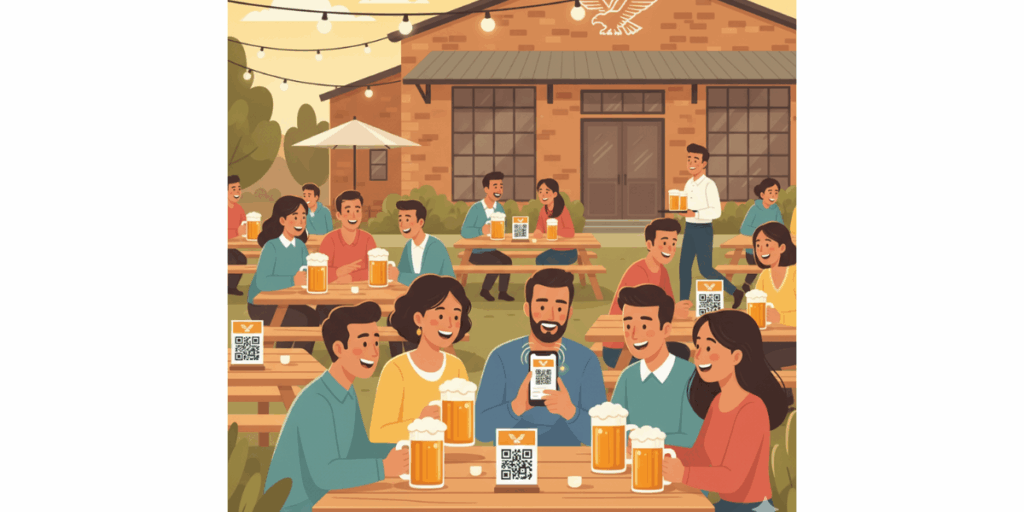
Sometimes the best way to understand the power of QR Codes is to see them in action. A standout example comes from Anheuser-Busch’s Biergarten, a brewery taproom and restaurant experience that wanted to modernize its service.
The challenge
The Biergarten team faced two common issues:
- Guests often had to wait for staff to take their orders, which slowed down service.
- Upselling items like desserts and drinks depended on servers remembering to ask, which was inconsistent.
They needed a way to make ordering more seamless, reduce staff workload, and boost sales without adding more people to the floor.
The solution: QR Code ordering
The Biergarten rolled out QR Code menus with integrated payment using Square’s ordering system. Each table had a QR Code that customers could scan to:
- Browse the digital menu
- Place orders directly from their phone
- Pay instantly without waiting for the check
This self-serve model gave customers full control of the dining experience.
The results
The impact was impressive:
- 35% of all food and drink orders started coming through QR Codes
- Average order value increased by 32% because guests could browse the full menu at their own pace and add items anytime
- Staff spent less time taking orders and processing payments, which meant they could focus more on hospitality and customer service
Scott Smith, Director of Brewery Services at Anheuser-Busch, summed it up:
“QR code ordering helped the Biergarten streamline orders. The days of servers remembering to ask if anyone saved room for dessert are over.” — Square Case Study
Why this matters for small businesses
This example shows that QR Codes are not just a gimmick. By empowering customers to order and pay directly, businesses can:
- Improve speed and convenience
- Increase average spend per visit
- Free up staff to deliver better customer experiences
Even if you’re a small café, food truck, or bar, adopting QR Code ordering can deliver similar benefits, helping you cut costs, grow revenue, and keep customers happy.
H. Best practices for QR Code implementation: Small businesses
Alright, you’re sold on using QR Codes—good call. But before you go slapping them on every surface within a 5-mile radius, let’s talk strategy. Because here’s the truth: a badly placed or poorly designed QR Code is worse than none at all.
You want your QR Codes to convert, not confuse. So here are some battle-tested best practices to make sure you’re using them the right way.
1. Make sure it’s scannable. Always
Sounds obvious, right? You’d be shocked how many businesses hide their QR Codes in the corner of a dark poster or shrink them down to the size of a postage stamp. Big mistake. Always test your code on multiple devices. Use high contrast (dark code on a light background), and keep it at least 1 x 1 inch at a minimum for print.
Pro tip: Don’t put your QR Code near a fold, crease, or busy background. It’ll get lost faster than your last business card.
2. Tell people what they’ll get
“Scan Me” isn’t enough anymore. Your customers need a reason. Are they scanning for a 10% discount? A free sample? A secret menu? Make it crystal clear what’s in it for them. The more specific, the better.
Example: Instead of “Scan Me,” try “Scan to Get 10% Off Your First Order” or “Scan to View Our Live Menu.”
3. Link to mobile-optimized pages
This is non-negotiable. If you’re sending people to a desktop-only site or a page that takes forever to load, you’re going to lose them faster than you can say “bounce rate.” Always test your landing page on a smartphone before going live.
4. Use dynamic QR Codes
Static QR Codes are fine—until they aren’t. If you ever need to change the URL or fix a typo, tough luck. With dynamic QR Codes, you can edit the link anytime, even after it’s printed. Total game-changer for campaigns, product packaging, menus—you name it.
Bonus: Dynamic codes let you track scans, locations, and devices, which means you actually get data to improve your campaigns.
5. Brand it like you mean it
QR Codes don’t have to be boring black-and-white blocks. Customize them with your brand colors, add your logo, and match the design to your vibe. It not only looks better, it builds trust.
Just don’t go too crazy with the customization. If the code gets too artsy and stops working, you’ve just created a very pretty failure.
6. Place them where action happens
Stick your QR Codes where your customers already are—and already paying attention. Think: countertops, receipts, product tags, table tents, storefront windows, event booths. Bonus points if it’s right when they’re ready to make a decision.
And no, slapping it in a random corner of your homepage doesn’t count. Be intentional.
7. Track, tweak, repeat
QR Codes are a set-it-and-forget-it tool only if you’re okay with guessing. If you’re serious about results, track those scans. See which locations, offers, or designs perform best, then double down on what works.
I. QR Code analytics: How to track and optimize engagement
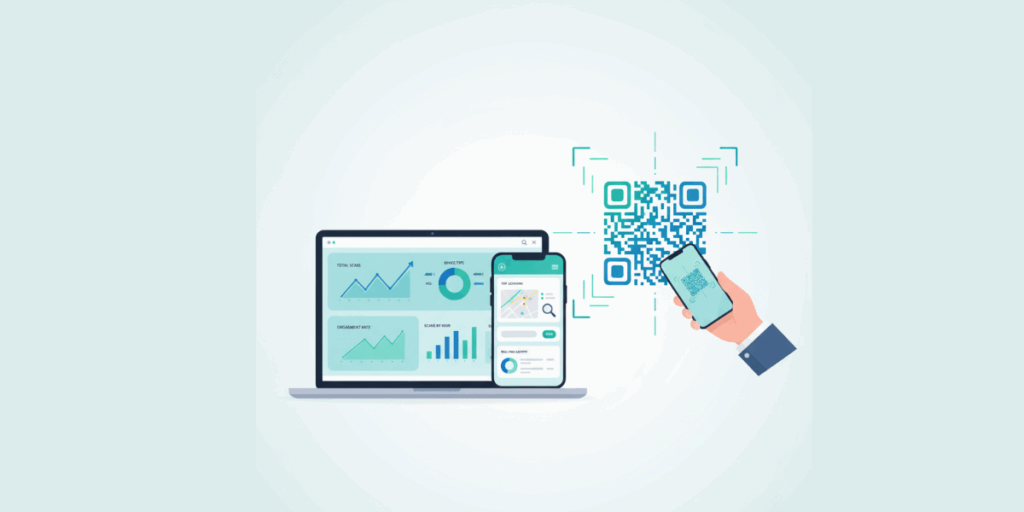
1. Track scans (because guessing isn’t a strategy)
Dynamic QR Codes let you see how many people are actually scanning your code. This isn’t just vanity data—it tells you which campaigns are working and which ones are flopping.
Pro tip: Look for a QR Code generator that offers real-time analytics so you can act fast.
2. Pay attention to the scan location and time.
Are people scanning your code in-store or online? On weekdays or weekends? Morning or evening? These insights help you tweak everything from timing to placement.
Example: If you see a spike in scans on Friday afternoons, that’s your window to launch limited-time offers.
3. Analyze the device type used
Knowing whether your users are on iPhones or Androids (or scanning from tablets) helps you optimize the user experience. For example, if most users are on mobile, your landing page better be fast and mobile-friendly.
Pro tip: Avoid sending users to a desktop-style form that takes 3 minutes to load. You’ll lose them before the page finishes loading.
4. Compare performance across campaigns
Running multiple QR Codes? Use unique tracking links for each one so you can compare results. Which poster, product label, or email footer is getting the most engagement? Now you’ll know.
Example: If your table tent QR Code is outperforming your receipts by 5X, maybe it’s time to ditch the receipt codes and go all in on table displays.
5. Optimize the journey after the scan
Lots of scans but no conversions? That’s a red flag. Maybe your landing page isn’t compelling. Maybe the CTA is weak. Or maybe the offer isn’t valuable. Use your analytics to pinpoint drop-off points and fix the leaks.
Example: A/B test different landing pages linked to the same QR Code to see which gets more clicks, signups, or purchases.
6. Adjust and improve—don’t set and forget
QR Code marketing isn’t “set it and forget it.” It’s “test, track, tweak, repeat.” Regularly check your analytics and make small changes that lead to big improvements over time.
Pro tip: Monthly check-ins with your QR Code data can reveal trends that help you plan smarter campaigns (and avoid wasting cash on what doesn’t work).
J. FAQs About QR Codes for Small Businesses
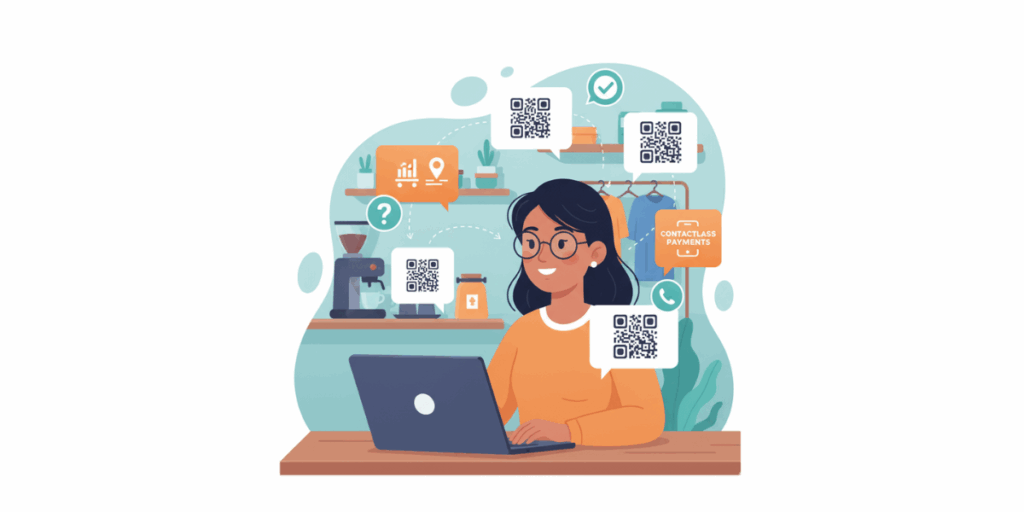
Q1. Which QR Code is best for small businesses?
Dynamic QR Codes are the best choice. Unlike static codes, they let you change the linked content anytime without reprinting. This is ideal if you run promotions, update menus, or change business details often. They also come with analytics so you can see how many people scanned, when, and where. This makes them much more versatile for marketing and customer engagement.
Q2. What is the difference between static and dynamic QR Codes?
A static QR Code stores fixed information such as a website URL or phone number. Once printed, it cannot be changed. A dynamic QR Code uses a short redirect link. This means you can edit the destination later, for example, switching from a seasonal campaign to your main website. Dynamic codes also support features like password protection, expiration dates, and scan tracking.
Q3. Can I update my QR Code after printing it?
Yes, but only if it is a dynamic QR Code. For example, if you printed flyers with a dynamic code that originally linked to a holiday discount page, you can later update it to link to a loyalty program without wasting your print materials. Static QR Codes cannot be edited, so you would need to print new ones every time.
Q4. Are QR Codes free to use?
Yes. Static QR Codes are free to create and use, but they are limited because they cannot be updated or tracked. Dynamic QR Codes usually come with a paid plan, but they offer major advantages such as editability, detailed analytics, and better design options. For a small business, investing in dynamic QR Codes can actually save money long-term by avoiding reprints and providing marketing insights.
Q5. How do I ensure customers scan my QR Code?
- Add a clear call-to-action (CTA) such as “Scan to order now” or “Scan for 20% off.”
- Place it where customers naturally look, such as store entrances, packaging, receipts, menus, or posters.
- Use high-contrast colors so the QR Code is easy to scan.
- Test it on multiple devices before publishing.
- Make the landing page mobile-friendly so customers have a smooth experience.
Q6. How can small businesses use QR Codes effectively?
Start small and focus on areas that matter most to your customers. For example, a restaurant can use QR Codes for digital menus and reviews, a boutique can add them on price tags for styling tips, and a salon can use them for quick appointment booking. Always track your results and adjust based on which QR Codes bring in the most engagement.
Q7. Are QR Codes safe for customers to scan?
Yes, QR Codes are safe when created and used responsibly. As a business owner, you should link your codes to trusted websites, secure payment gateways, or well-known platforms. Customers are more likely to scan when they see your code on official business materials such as receipts, packaging, or signage. Adding your brand logo or a short CTA also increases trust.
Brands that trust us:
Ready to boost your small business with QR Codes?
Start your free trial with Scanova, customize your first QR Code, and get real-time insights to grow your customer base, no tech skills needed.
